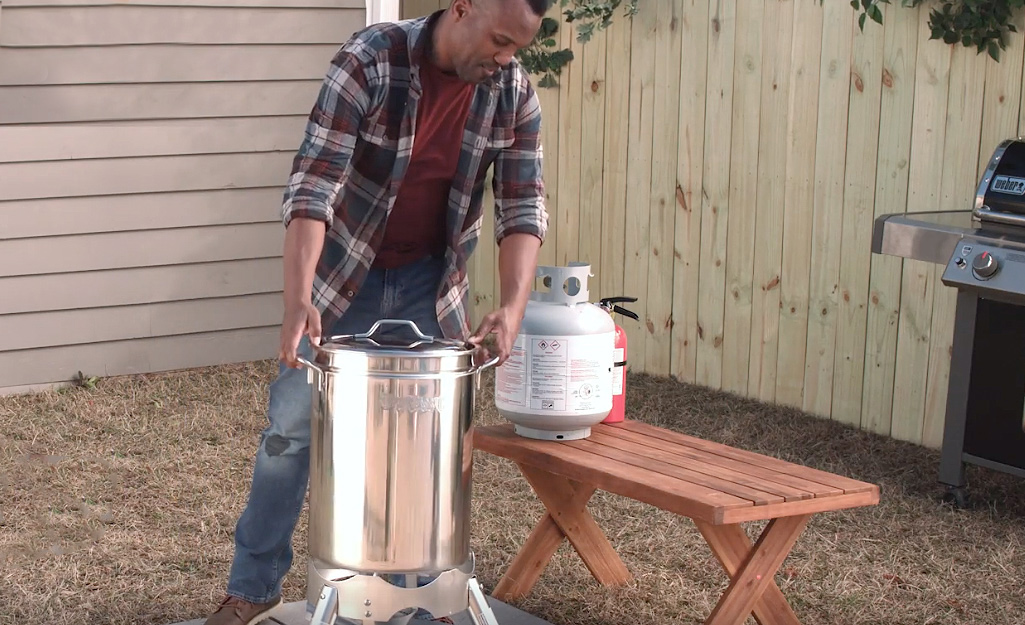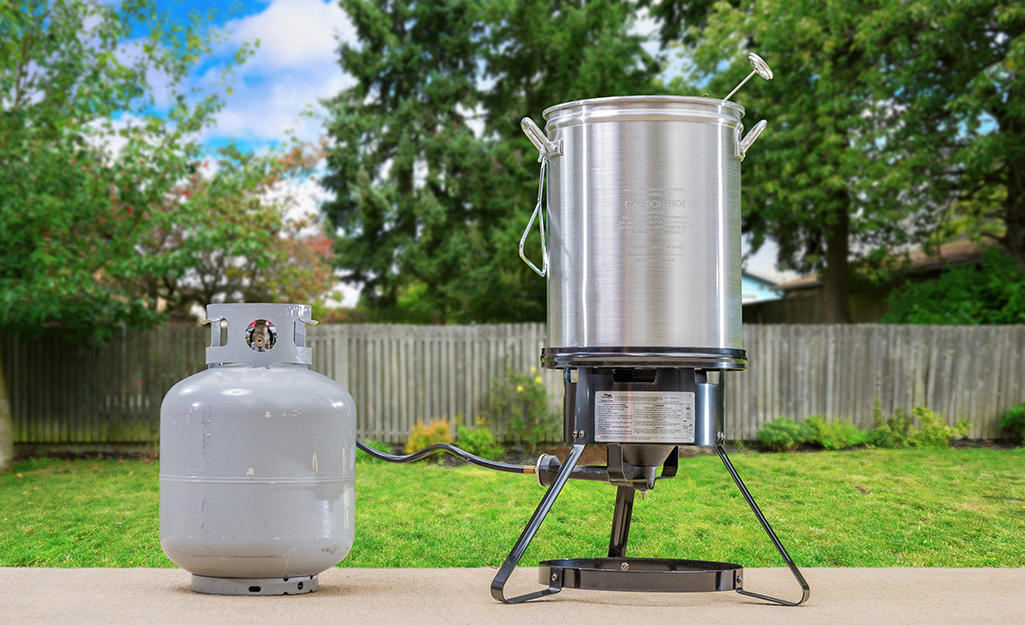Deep frying a turkey isn’t just for Thanksgiving. It’s a method to quickly prepare a delicious bird any time of year. You need to understand the ins and outs of deep-frying turkey if you want to prepare this holiday staple while adhering to safety regulations.
You can safely deep fry a turkey indoors or outdoors with the help of this guide, which also includes setup instructions for your turkey fryer. Common queries like “How much oil do I need?” and “How long does it take to fry a turkey?” will also be addressed in this guide.
Safety Advice: Avoid frying frozen turkeys as they may explode in the hot oil, posing a risk of burns and injuries. Make sure your turkey is completely thawed before frying. Jump to Specific Section.
Thanksgiving is a time for family, feasting, and, of course, turkey. While traditional oven-roasted turkey remains a classic, deep-frying offers a unique and flavorful alternative. But what about stuffing? Can you deep fry a stuffed turkey? The answer is a bit more nuanced than a simple yes or no
The Traditional Approach: Deep-Frying a Whole Turkey
Deep-frying a whole turkey has become increasingly popular, offering a crispy exterior and juicy meat. However, stuffing a whole turkey before deep-frying is not recommended. The stuffing can hinder heat penetration, potentially leading to an undercooked center and overcooked exterior. Additionally, the high temperatures involved in deep-frying can cause the stuffing to become dry and crumbly.
The Bon Appétit Twist: Deep-Fried Turkey Tenders with Stuffing Crust
Bon Appétit magazine presents a creative solution: deep-fried turkey tenders coated in a flavorful stuffing crust. This method offers the crispy, deep-fried texture with the comforting taste of stuffing all in bite-sized portions.
The Process:
- Prepare the Turkey Tenders: Cut a 3-pound turkey breast into 1-inch strips, resembling “jacked-up chicken tenders.” Season generously with a mixture of kosher salt, sugar, and freshly ground pepper. Refrigerate for at least two hours.
- Make the Stuffing Batter: Combine flour, cornstarch, poultry seasoning, garlic powder, onion powder, salt, baking powder, and black pepper in a large bowl. In a separate bowl, whisk together eggs and buttermilk.
- Triple-Dip the Tenders: Dredge each tender in the dry mixture, followed by the wet mixture, and finally back into the dry mixture, creating a thick and flavorful coating. Return the tenders to the refrigerator to rest.
- Deep-Fry to Perfection: Heat a large pot of oil to 325°F. Fry the tenders in batches until golden brown and cooked through. Drain on paper towels and serve immediately.
The Verdict: Deep-Frying a Stuffed Turkey
While deep-frying a whole stuffed turkey is not advisable, Bon Appétit’s innovative approach offers a delicious alternative. By deep-frying turkey tenders coated in a stuffing crust, you can enjoy the best of both worlds: crispy texture, juicy meat, and the comforting flavors of Thanksgiving stuffing.
Additional Considerations:
- Safety First: Deep-frying involves hot oil, so exercise caution and follow safety guidelines. Use a deep fryer or a large pot specifically designed for deep-frying, and never leave the fryer unattended.
- Oil Choice: Use high smoke point oils like peanut or vegetable oil for deep-frying.
- Cooking Time: The cooking time for deep-fried turkey tenders depends on their thickness. Aim for 5-7 minutes, adjusting as needed.
- Internal Temperature: Ensure the internal temperature of the turkey reaches 165°F (75°C) for safe consumption.
- Stuffing Alternatives: If you prefer traditional stuffing, bake it separately in a casserole dish while the turkey tenders are deep-frying.
Deep-frying a stuffed turkey may not be the most conventional approach, but with a little creativity and Bon Appétit’s ingenious recipe, you can create a unique and flavorful Thanksgiving feast that will impress your guests. Remember to prioritize safety and follow proper deep-frying techniques for a successful and delicious culinary experience.
How to Set Up Your Turkey Fryer

How to set up an outdoor turkey fryer:
- A burner, stand, pot, thermometer, hanger or basket, and lowering mechanism are all included in an outdoor turkey fryer. You’ll need to provide a propane tank.
- Choose an open space to set up your outdoor fryer. It ought to be at least ten feet away from the house in all directions on a level, level, and hard surface. Never place the fryer or propane tank on a combustible surface like wood or asphalt (blacktop).
- Reassemble the burner and stand in accordance with the manufacturer’s instructions for your fryer.
- Verify that nothing is above the flame or the pot.
- Attach the fryer’s gas line to the propane tank. As far as the line will allow, place the propane tank away from the fryer without stretching it.
- Determine how much oil you’ll need for the pot. To do this, substitute water for oil in a test run. Put both in the fryer pot and the thawed turkey in the fryer basket. Fill the pot with water until it reaches about a half-inch above the turkey’s top. Raise the fry basket and turkey, letting the water return to the pot after draining. Using a food-safe pencil or marker, you can indicate the water level and use that line as a guide when adding oil. Alternatively, you can use measuring cups to determine how much water is in the pot as you remove it.
- Thoroughly wash and dry the fryer pot before cooking.
How to set up an indoor turkey fryer:
- An indoor turkey fryer is a large countertop fryer. Compared to outdoor fryers, these single-unit fryers are usually safer, more adaptable, and easier to operate. Nevertheless, their cost is typically higher than that of outdoor fryers, and their capacity might be lower.
- Follow the manufacturer’s instructions for your particular fryer model.
- Typically, using an indoor fryer only requires adding oil to the fryer to the pre-marked level and using the fryer basket to lower the fresh or thawed turkey inside.
The most common oil to use when deep-frying a turkey is peanut oil, but any oil that has a smoking point of 450 degrees Fahrenheit will do the job. Try safflower oil or corn oil if you don’t like peanut oil or are accommodating a peanut allergy.
Safety Tips for Deep Frying a Turkey

- One of the most frequently mishandled varieties of outdoor cookers is the turkey fryer, frequently because of setup inexperience.
- When using a fryer or other outdoor cooker, always wear protective shoes, a BBQ apron, and mitts.
- Place a minimum of one grease fire extinguisher close to the fryer setup. Even though using an indoor fryer is safer, always keep a fire extinguisher close at hand.
- Never try using an indoor fryer outside or an outdoor fryer inside.
- Pets and children should never be allowed in the vicinity of a fryer at any time.
- Do not drink alcohol while operating a turkey fryer.
- Never leave the fryer unattended, even for a moment.
- The gas line can be a trip hazard and could topple the pot, so never walk between the propane tank and the turkey fryer.
- Plan on being outside for a couple of hours.
- Turn off the burner and the gas supply right away if the fryer’s oil begins to smoke or reaches a temperature higher than 400 degrees Fahrenheit. Then, wait for the oil to cool down to 350 degrees Fahrenheit.
- Never move the fryer when it’s in use. Allow it to cool completely before moving, cleaning and storing.
- The internal temperature of dark meat must be between 175 and 180 degrees Fahrenheit.
- The internal temperature of white meat needs to be between 165 and 170 degrees Fahrenheit.
Safety Tip: Frying a turkey involves heating oil to 350 degrees Fahrenheit. Before attempting to use a fryer, thoroughly read all manufacturers instructions and warnings. Follow safety precautions regardless of whether youre deep frying a turkey indoors or out.
Stuffing Setup for Deep Frying a Thanksgiving Turkey
FAQ
Is it safe to deep-fry a turkey inside?
Can you deep-fry a Butterball turkey?
How do you deep-fry a turkey without blowing it up?
How big of a turkey can you put in a deep fryer?
